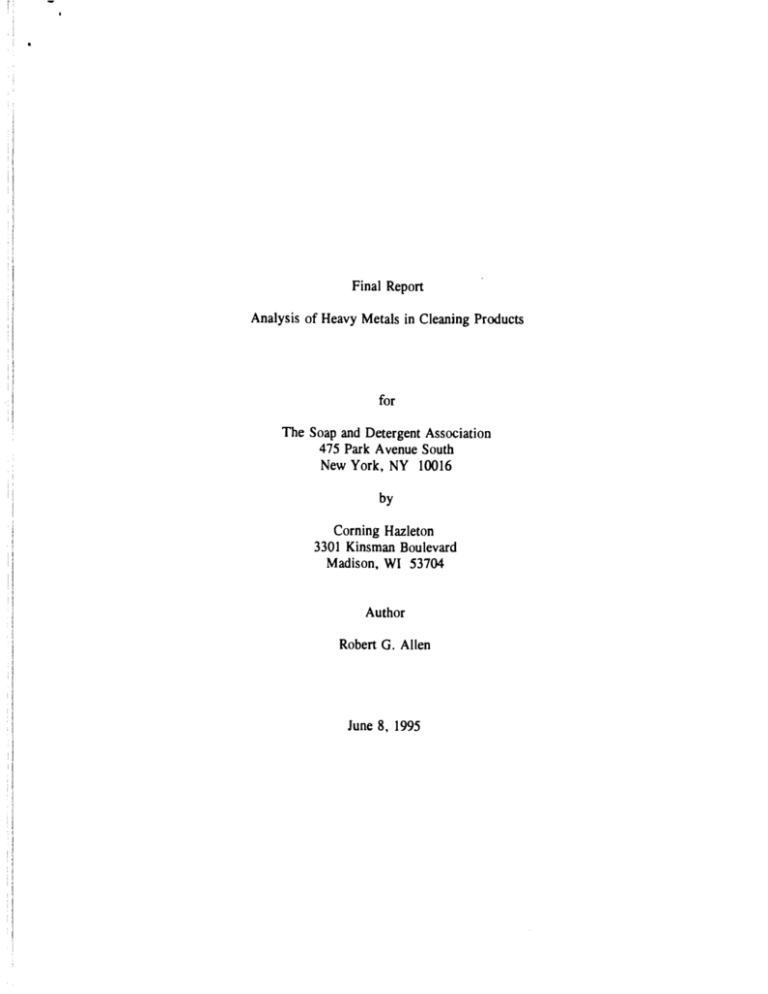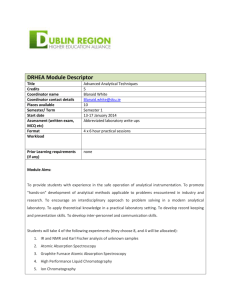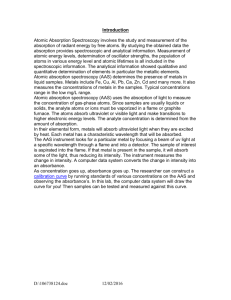Final Report Analysis of Heavy Metals in Cleaning
advertisement

Final Report Analysis of Heavy Metals in Cleaning Products for The Soap and Detergent Association 475 Park Avenue South New York, NY 10016 by Corning Hazleton 3301 Kinsman Boulevard Madison. WI 53704 Author Robert G. Allen June 8, 1995 2 CONTENTS Page INTRODUCTION 3 SAMPLE COLLECTION 3 COMPOSITING PROCEDURE 3 MATERIALS 3 SAMPLE ANALYSIS 4 SIGNATURE 5 TABLES 1. 2. 3. 4. 5. 6. Product Brands to be Collected and Composited Sample Collection Compositing Procedure Instrument Parameters Atomic Absorption Analytical Results Method References 6 7 8 9 10 11 3 INTRODUCTION Composite samples of powder laundry detergent were analyzed for arsenic, cadmium, chromium, copper, lead, mercury, nickel, silver, and zinc to develop background information on the potential contribution of these products to the heavy metal contamination of municipal sewage. The Soap and Detergent Association (SDA) previously sponsored a study in which the concentrations of these same heavy metals were measured in composite samples of seven categories of cleaning products which are known to be disposed into sewage. Since the completion of this study, powder laundry detergents have undergone widespread reformulation. This matrix was reexamined to determine if the heavy metal content was altered. SAMPLE COLLECTION Eleven different brands of powder laundry detergent were collected from stores in three California cities: Sunnyvale, Palo Alto, and San Jose. A 35 - 45 ounce container was to be purchased in each municipality. Table I was reprinted from The Soap and Detergent Association scope of work and lists the product brands to be collected and composited. Table 2 lists the container size collected in each area. COMPOSITING PROCEDURE Eleven within-brand composites were prepared by combining each of the single containers from each of the three cities. From these composites, a subsample was removed based on the market share to prepare the between-brand composite (Table 3). A total of 600 grams was prepared and subdivided into three acid-washed polyethylene bottles (amber, wide-mouthed, 250 mL size). Two of these samples were used for analysis and the third was kept as a reserve sample. MATERIALS Reagents • • • • • Water, double-deionized, in-house Nitric acid, Mallinckrodt Chemical, Inc., Paris, Kentucky Sulfuric acid, Fisher Scientific, Pittsburgh, Pennsylvania Sodium borohydride, Aldrich Chemical Company, Milwaukee, Wisconsin Stock standard solutions, Fisher Scientific, Pittsburgh, Pennsylvania Equipment • General laboratory glassware, Coring Glassworks, Corning, Instrumentation • • Spectrophotometer, Models 3300 and 5000, Perkin Elmer Mercury/hydride system, Perkin Elmer Model MHS-20 ~ew York 4 SAMPLE ANALYSIS Cadmium. Chromium. Copper. Lead. Nickel. Silver. and Zinc The samples were digested with nitric acid in glass beakers on a hot plate, transferred to 50 mL volumetric flasks, filtered, and analyzed by atomic absorption spectroscopy. Arsenic The samples were digested with a mixture of sulfuric and nitric acids, transferred to 25 mL volumetric flasks, and analyzed by hydride generation. Mercury The samples were digested with a mixture of sulfuric and nitric acids, transferred to 100 mL volumetric flasks, and analyzed by cold vapor atomic absorption spectroscopy. All of the analyses were performed using atomic absorption spectroscopy. The instrument operating parameters are included in Table 4. Analytical results are listed in Table 5. Spikes were prepared to test for matrix effects. The amount of each analyte added and the respective percent recovery are listed in Table 5. Recoveries ranged from 80.5 - 125 %. 5 SIGNATURE ~~ ~ l . QU..I.olOo~- Robert G. Allen Supervisor Inorganic Chemistry by and for Corning Hazleton Date 6 Table I Product Brands To Be Collected and Composited4 Powder Laundry Detergents Brand Manufacturer Tide Tide with bleach Surf Cheer Arm & Hammer Wisk Purex All Bold Gain Fab Procter & Gamble Procter & Gamble Lever Brothers Procter & Gamble Church & Dwight Lever Brothers Dial Lever Brothers Procter & Gamble Procter & Gamble Colgate-Palmolive Market Share! Cumulative Share Densi ty2 (gm/L) 23.8 10.6 8.1 7.9 6.6 6.2 5.6 5.2 2.4 2.3 1.8 23.8 34.4 42.5 50.4 57.0 63.2 68.8 74.0 76.4 78.7 80.5 560.5 607.0 560.0 560.0 640.0 560.0 400.0 600.0 557.8 560.5 550.0 Weighting Factor3 29 14 10 10 9 8 5 7 3 3 2 !Information Resources, Inc., personal communication, 1994. 2Personal communications with manufacturers. 3Weighting factor = [Powder detergent market share x Density] / E[Powder detergent market share x Density] x 100 4Reprinted from The Soap and Detergent Association scope of work. 7 Table 2 Sample Collection Brand Tide Tide with Bleach Surf Cheer Arm & Hammer Wisk Purex All Bold Gain Fab Sunnyvale City Palo Alto San Jose 420z 470z 420z 420z 4.51b 420z 66 oz 480z 420z 420z 6 lb 2 oz 420z 470z 420z 420z 4.51b 420z 66 oz 480z 420z 420z 1 420z 470z 420z 420z 4.51b 420z 660z 480z 420z 420z 420z 1 This brand could not be located in Palo Alto. 8 Table 3 Compositing Procedure Power Laundry Detergent Tide Tide with Bleach Surf Cheer Arm & Hammer Wisk Purex All Bold Gain Fab Weight (grams) 174 84 60 60 54 48 30 42 18 18 12 9 Table 4 Instrument Parameters Atomic Ahsorption Analytical Wavelength Element Techniaue Instrument Arsenic Cadmium Chromium Copper Lead Mercury Nickel Silver Zinc Hydride Flame Flame flame Flame Hydride Flame Flame Flame PE PE PE PE PE PE PE PE PE PE 5000/MHS-20 3300 5000 3300 5000 5000/MHS-20 3300 5000 3300 Perkin Elmer Corp., Norwalk, CT MHS-20 QP Perkin Elmer Mercury/Hydride System ~nm) 193.7 228.8 357.9 324.7 283.3 253.7 232.0 328.1 213.9 Standard Solutions Range Silt (nm) Gases 0.7 0.7 0.7 0.7 0.7 0.7 0.2 0.7 0.7 Argon (carrier) Air/acetylene N]O/acetylene Air/acetylene Air/acetylene Argon (carrier) Air/acetylene Air/acetylene Air/acetylene !mmll 0.0 - 0.030 0.02 - 1.0 0.1 - 5.0 0.02 - 1.0 0.0 - 3.0 0.0 - 0.050 0.1 - 5.0 0.05 - 1.0 0.05 - 2.0 10 Table 5 Analytical Results Analyte Concentration (mg/Kg) Powder Laundry Detergent Assay I As 0.295 Cd <0.20 Cr < 1.00 Cu 1.52 Pb 0.18 Hg <0.025 Ni < 1.00 Ag 1.01 Zn 4.02 Assay 2 0.308 <0.20 < 1.00 1.63 0.20 <0.025 < 1.00 1.08 4.11 Analyte Added (lLg) 1.00 4.0 20.0 8.0 4.0 0.20 10.0 10.0 20.0 105. 97.5 125. 117. 92.8 lOt. 80.5 103. 116. Recovery (%) 11 Table 6 Method References Arsenic by Hydride Generation Digestion: Analytical Methods Committee, The Analyst, Volume 85, Pages 643-656 (1960) (Modified). Perkin Elmer, Analytical Methods Using the MHS Mercury/Hydride System, Norwalk, CT., January, 1981 (Modified). Cadmium Official Methods of Analysis of the Association of Official Analytical Chemists, 15th Edition, Method 974.27, Arlington, VA., (1990) (Modified). Perkin Elmer, Analytical Methods for Atomic Absorption Spectrophotometry, Norwalk, Ct., January 1982 (Modified) Methods for Chemical Analysis of Water and Wastes (1979), Metals 1-19 and Method 213.1, U.S. EPA, Cincinnati, OH (Modified). Chromium Perkin Elmer, Analytical Methods for Atomic Absorption Spectrophotometry, Norwalk, CT, January 1982 (Modified). Methods for Chemical Analysis of Water and Wastes (1979), Metals 1-19 and Method 218.1, U.S. EPA, Cincinnati, OH (Modified). Lead Official Methods of Analysis of the AOAC, 15th Edition, Methods 972.23, 973.35 and 974.27, AOAC, Arlington, VA. (1990) (Modified). Friend, M.T., Smith, C. A., and Wishart, D., Atomic Absorption Newsletter, Volume 16, No.2, Pages 46-49 (1979) (Modified) Mercury Digestion: Analyst, Volume 86, Page 608 (1961) (Modified). Determination: Analytical Chemistry, Volume 40, Page 2085 (1968) (Modified). Nickel Perkin Elmer, Analytical Methods for Atomic Absorption Spectrophotometry, Norwalk, CT, January 1982 (Modified). Methods for Chemical Analysis of Water and Wastes (1979), Metals 1-19 and Method 249.1, U.S. EPA, Cincinnati, OH (Modified). 12 Table 6 (Continued) Silver Perkin Elmer, Analytical Methods for Atomic Absorption Spectrophotometry, Norwalk, CT, January 1982 (Modified). Methods for Chemical Analysis of Water and Wastes (1979), Metals 1-19 and Method 272.1, U.S. EPA, Cincinnati, OH (Modified). Zinc Official Methods of Analysis of the Association of Official Analytical Chemists, 15th Edition, Methods 965.09, 968.08, 969.32 and 985.35, Arlington, Virginia (1990) (Modified).





